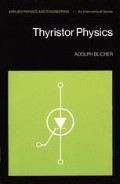Summary
Thyristors are three-terminal solid-state switches whose bistable state depends on a regenerative feedback mechanism occuring in a p-n-p-n structure.
The silicon-controlled rectifier (SCR) is a device belonging to the class of thyristors with the ability of unidirectional conduction. After defining the switching and holding points of an SCR, the gate turn-on conditions are examined, and it is shown that the V–I coordinates of the switching point are dependent on small-signal current gains of the p-n-p and n-p-n SCR sections. The turn-on occurs when the sum of small-signal alphas is equal to unity.
In the case of a shorted emitter, the turn-on condition is simplified to a product of small-signal current gain and avalanche multiplication factor Mα 1= 1.
At zero potential applied to the center junction the current flowing through the device is I v and at this current level the sum of DC alphas αN and αP is equal to unity.
The holding current I h is greater than I 1 and, therefore, the V–I coordinates of the holding point are dependent on the sum of DC alphas.
Access this chapter
Tax calculation will be finalised at checkout
Purchases are for personal use only
Preview
Unable to display preview. Download preview PDF.
References
W. Fulop. Three terminal measurements of current amplification factors of controlled rectifiers. IEEE Trans. Electron Devices, 10: 120–135, 1963.
F. E. Gentry. Turn on criteria for pnpn devices. IEEE Trans. Electron Devices, ED-11: 74, 1964.
J. F. Gibbons. A critique of the theory of pnpn devices. IEEE Trans. Electron Devices, ED-11: 406–413, 1969
J. F. Gibbons. and Graphical analysis of the I-V characteristics of generalized pnpn devices. Proc. IEEE, 55 (8): 1366–1374, 1967.
R. W. Aldrich and N. Holonyak, Jr. Two-terminal asymmetrical and symmetrical silicon negative resistance switches. J. Appl. Phys., 30: 1819–1824, 1959.
F. E. Gentry, F. W. Gutzwiller, N. Holonyak, Jr., and E. E. Von Zastrow. Semiconductor Controlled Rectifiers. Englewood Cliffs, N.J.: Prentice-Hall, 1964.
Also of interest
W. Fulop, W. Fong Yan, M. R. Joadat-Ghasabi, and C. A. Hogarth. Three-terminal current gain measurements of high-power thyristors. Int. J. Electron., 33 (6): 601–609, 1972.
Author information
Authors and Affiliations
Rights and permissions
Copyright information
© 1976 Springer-Verlag New York Inc.
About this chapter
Cite this chapter
Blicher, A. (1976). Device basics. In: Thyristor Physics. Applied Physics and Engineering, vol 12. Springer, New York, NY. https://doi.org/10.1007/978-1-4612-9877-9_1
Download citation
DOI: https://doi.org/10.1007/978-1-4612-9877-9_1
Publisher Name: Springer, New York, NY
Print ISBN: 978-1-4612-9879-3
Online ISBN: 978-1-4612-9877-9
eBook Packages: Springer Book Archive

